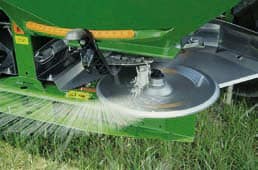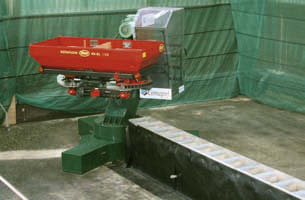Too much fertilizer? A globally unique test bench for investigation and analysis
Cemagref, the French Institute for Agricultural and Environmental Engineering Research is a specialist in spreading fertilizer at one of its nine sites in Montoldre. The equipment to chart the spread of the fertilizer as it is ejected by centrifugal spreaders of mineral fertilizer, is globally unique.
Investigating fertilizer spreading: the limits of the current system of evaluation
Up until 2006, the amount of fertilizer that was spread was expressed as the transverse distribution to the axis of progression of the machine in a complete pass. As an already integrated outcome was provided, extensive analyses were required to optimize the spread of the fertilizer and thus minimize environmental pollution.
But increasing the power of the fertilizer spreader produced so many set points that it became virtually impossible to optimize the machines without having recourse to models of the spread, created under real conditions. So the conventional test bench was inadequate for future requirements.
A revolutionary test bench principle
Fertilizer spreaders distribute fertilizer via two spinning disks, ejecting the fertilizer backwards and sideways out of the machine. The distribution over the soil corresponds to a circular layer of varying density. The control station, for
which Cemagref has applied for a patent, works on the basis of radial measurement of the distributed quantities:
During a spreading test, the machine is set to rotate around itself. The distributed layer is charted for each angular sector by receiving containers arranged radially around the center of rotation. The result is the actual distribution of the fertilizer on the soil. There are several data processing phases as first, the spread is characterized and then a model of the distribution over the soil is created.
Academics and engineers can then work with objective measurement results and are no longer dependent on bold interpretations. This technical innovation also has a practical advantage: at 40 m x 1 m, the place where the test bench is installed is 15 times smaller, which makes it far more economical.
80 load cells with a measuring range of up to 1 kg weigh the quantities of fertilizer received by the 80 containers. All the load cells are continuously and synchronously interrogated with the aid of MGCplus at a frequency of up
to 2400 Hz. The obtained resolution of 0.02 g allows the mass accumulation in each container to be measured by the grain. The simultaneous measurement of the relative angle of the centrifugal fertilizer spreader in relation to the series of containers allows the average fertilizer density to be derived in each physical
position of the layer.
The chart made of the layer spread over 220° takes one to three minutes, depending on the measurement accuracy required. Three RTN load cells with a measuring range of up to 2.2 t allow simultaneous measurement of the complex made up of revolving support, fertilizer spreader and fertilizer. The loss in weight is measured continuously at a resolution of 20 g. This allows the flow to be recorded at the outlet of the fertilizer spreader.
Easy data acquisition with MGCplus and catman®
All the load cells used are calibrated or simply tested remotely, without the need for adjustments to be made on the test bench itself. Because there is a direct connection to the MGCplus amplifier system and a useful calibration window in the catman® software, amplifications and offsets are simply adjusted.
The recordings of the load cells used guarantee that sequences can be retraced. A series of catman® display windows allow the measurement data of all the load cells to be monitored in real time. The program supports links to other programs (database, processing software) and no intervention is required from the user.
Thanks to this technology, a new and full test (parameterization, test, saving and processing the data) can be run every five minutes.

